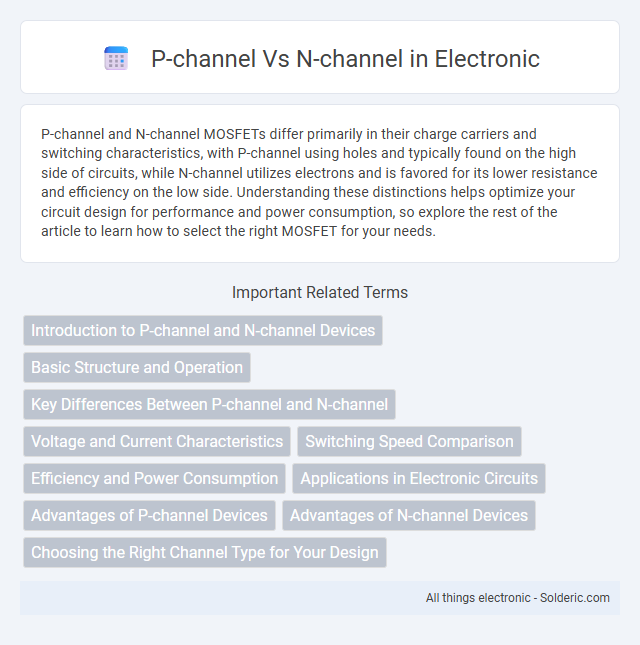P-channel and N-channel MOSFETs differ primarily in their charge carriers and switching characteristics, with P-channel using holes and typically found on the high side of circuits, while N-channel utilizes electrons and is favored for its lower resistance and efficiency on the low side. Understanding these distinctions helps optimize your circuit design for performance and power consumption, so explore the rest of the article to learn how to select the right MOSFET for your needs.
Comparison Table
| Feature | P-Channel MOSFET | N-Channel MOSFET |
|---|---|---|
| Charge Carriers | Holes | Electrons |
| Symbol Polarity | Source at higher potential | Source at lower potential |
| Threshold Voltage (Vth) | Negative | Positive |
| Switching Speed | Slower | Faster |
| On-State Resistance (Rds(on)) | Higher | Lower |
| Common Usage | High-side switching | Low-side switching |
| Input Voltage for ON | Gate must be lower than source | Gate must be higher than source |
| Cost | Generally higher | Generally lower |
| Applications | Power regulation, load switching | Power management, amplification |
Introduction to P-channel and N-channel Devices
P-channel and N-channel devices are types of MOSFETs used in electronic circuits for switching and amplification. N-channel MOSFETs conduct when a positive voltage is applied to the gate relative to the source, offering lower on-resistance and higher electron mobility. P-channel MOSFETs turn on with a negative gate voltage relative to the source, typically used in high-side switching applications due to their simplified gate drive requirements.
Basic Structure and Operation
P-channel MOSFETs consist of a p-type semiconductor channel between two n-type regions, operating by allowing current flow when the gate voltage is lower than the source voltage. N-channel MOSFETs have an n-type channel between p-type regions and conduct current when the gate voltage exceeds the source voltage. Your choice depends on the required polarity for switching and current flow direction in your circuit.
Key Differences Between P-channel and N-channel
P-channel and N-channel MOSFETs differ primarily in their charge carriers, with P-channel using holes and N-channel using electrons, affecting their conductivity and switching characteristics. N-channel MOSFETs generally offer lower on-resistance and higher electron mobility, making them more efficient for high-speed switching and power applications. P-channel MOSFETs are typically used in high-side switch configurations due to their simpler gate driving requirements, despite having slower switching speeds compared to N-channel devices.
Voltage and Current Characteristics
P-channel MOSFETs typically operate with negative gate-to-source voltages and conduct when the gate voltage is lower than the source, whereas N-channel MOSFETs require positive gate-to-source voltages and conduct when the gate voltage is higher than the source. N-channel devices generally offer higher electron mobility, resulting in lower on-resistance and higher current-carrying capability compared to P-channel devices. The voltage and current characteristics of N-channel MOSFETs make them more efficient for high-speed switching and higher power applications.
Switching Speed Comparison
N-channel MOSFETs generally exhibit faster switching speeds than P-channel MOSFETs due to higher electron mobility compared to holes, enabling quicker charge carrier movement. This difference significantly impacts efficiency in high-frequency applications, where switching speed is critical. Optimizing Your circuit design often involves selecting N-channel devices for faster switching performance and improved overall response time.
Efficiency and Power Consumption
P-channel MOSFETs generally exhibit higher on-resistance compared to N-channel MOSFETs, leading to increased power consumption and reduced efficiency in switching applications. N-channel devices offer lower conduction losses due to better electron mobility, making them more suitable for high-efficiency power management tasks. Choosing the right channel type affects your circuit's overall energy efficiency and regulates heat dissipation effectively.
Applications in Electronic Circuits
P-channel MOSFETs are commonly used in high-side switch applications where controlling the positive voltage supply is essential, making them ideal for battery-powered devices and load switching. N-channel MOSFETs offer lower on-resistance and higher current capacity, making them preferable for low-side switching, power amplification, and driver circuits in power management systems. Your choice between P-channel and N-channel transistors directly impacts efficiency and thermal performance in electronic circuit designs.
Advantages of P-channel Devices
P-channel devices offer advantages such as simpler high-side switching in power management circuits, making them ideal for load control applications where positive voltage switching is needed. Their ability to conduct when the gate voltage is lower than the source voltage enables efficient design in battery-powered systems. You benefit from reduced component count and easier circuit layout when using P-channel MOSFETs for certain topology requirements.
Advantages of N-channel Devices
N-channel MOSFETs offer higher electron mobility, resulting in lower on-resistance and improved conduction efficiency compared to P-channel devices. This translates to better performance in power switching applications, enabling higher current capacity and faster switching speeds. Their superior efficiency and thermal characteristics make N-channel devices the preferred choice for most high-performance electronic circuits.
Choosing the Right Channel Type for Your Design
Choosing the right channel type for your design hinges on the specific application requirements such as switching speed, voltage levels, and power efficiency. N-channel MOSFETs typically offer lower on-resistance and higher electron mobility, making them ideal for high-speed and high-current applications. P-channel MOSFETs, while generally slower and with higher resistance, simplify circuit design by allowing high-side switching without additional components, making them suitable for certain power management tasks.
P-channel vs N-channel Infographic

 solderic.com
solderic.com